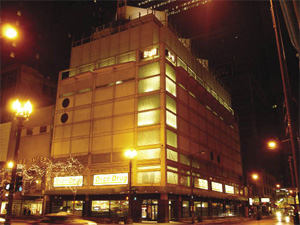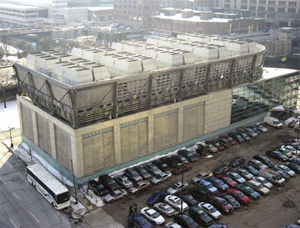Chicago boasts of an impressive district cooling system serving about 100 buildings and 45 million square feet of space in its downtown area. Peter B Myers gives the highlights.
Chicago boasts of an impressive district cooling system serving about 100 buildings and 45 million square feet of space in its downtown area, which members of the IDEA Conference will tour in 2012. Peter B Myers gives the highlights.
The 103rd IDEA Annual Conference and Trade Show at the Hyatt Regency Chicago will be held from June 30 to July 3, 2012. The theme of the conference is “Cooler, Cleaner Cities”. The event claims to be filled with stimulating presentations, workshops and networking opportunities, along with a trade show featuring premiere engineering, manufacturing and consulting firms from around the globe.
When members of the International District Energy Association gather for the annual conference, they will be visiting one of the most popular tourist destinations in the United States. Each year, more than 40 million travellers from around the world visit the cosmopolitan city located on the southern tip of Lake Michigan. When the Conference delegates arrive, they will find plenty to see and do. The city boasts of many attractions, like The Museum of Science and Industry, which is the largest science museum in the Western Hemisphere; the McCormick Place, a convention centre, with the largest exhibit space in North America (2.2 million square feet); The Willis Tower (formerly the Sears Tower), the tallest building in the Western Hemisphere, at 110 stories high; and The Merchandise Mart, the world’s largest commercial building and wholesale design centre, with 4.2 million gross square feet spanning two city blocks.

Plant 1 in the Thermal Chicago system is located in an area zoned for retail, allowing the first floor to be occupied by a tenant while the rest of the building houses an ice/chilled water plant.
The city is also known for many engineering accomplishments, including the herculean effort in 1900 to reverse the flow of the Chicago River so that it empties into the Mississippi River instead of Lake Michigan. But one of Chicago’s engineering achievements that is not typically found on a sightseeing tour is the extensive district cooling system. Like other district energy systems, most of it is underground, and even the parts that are above ground go largely unnoticed. However, the system has become a vital component of the city’s infrastructure. And tours of the Thermal Chicago system will be a highlight on the itinerary of the Annual Conference and Trade Show delegates.
Thermal Chicago Corporation owns and operates the world’s largest interconnected district cooling system, serving about 100 buildings and 45 million square feet of space in downtown Chicago. The system includes five interconnected plants serving the Loop, West Loop, South Loop and River North areas. Thanks to its proven reliability and multiple benefits, customers have increasingly turned to Thermal Chicago’s district cooling service as an alternative for both new and replacement air conditioning systems. Its contract capacity has increased from about 92,000 tonnes in 2004 to more than 105,000 tonnes today, representing an average annual increase of two per cent. Its mixed customer base includes commercial and industrial facilities, office towers, condominiums, apartment buildings, theatres, hotels, data centres, retail centres and schools.
Unlike many district cooling systems, which utilise a single type of technology throughout, Thermal Chicago employs several different technologies, including ice tank storage, ammonia chillers and river water chillers. The largest plant, P2, contains the world’s largest ice tank, holding two million gallons of chilled water. It can deliver 125,000 tonne-hours of cooling to the system, representing about an eighth of the network’s capacity. Ice is made during the night, when electric demand and cost are low, and is, then, stored and allowed to melt slowly the following day to meet demand. This reduces clients’ electrical needs during the day, flattening out their load profiles while also reducing stress on the grid. By using ice, Thermal Chicago can avoid 40 MW of peak load on the grid for a short period of time and 20 MW for a longer period of time. In addition, customers benefit from water-usage reductions of up to 25% compared to using on-site chillers and cooling towers.

Plant 2 features an evaporative condenser design; it is the largest plant in the Thermal Chicago system and features the largest ice system. Photos courtesy: Thermal Chicago
Another ice-making plant, P3, can be found in the basement of the Blue Cross/Blue Shield of Illinois headquarters on Randolph Street, overlooking Millennium Park. This plant houses three large ice tanks and an ammonia chilling plant.
The ammonia chillers do not create ozone-depleting emissions and greenhouse gases. Thermal Chicago employs sophisticated leak control devices to monitor the ammonia to ensure maximum public safety.
River water cooling has been used in riverside buildings for decades. Thermal Chicago has two plants that use river water as the ultimate heat sink. One of these plants was originally installed in the 1950s to provide cooling for the Merchandise Mart. It was expanded in 2000 when it became plant P4 in the Thermal Chicago system. Another river water plant, P5, was installed two years later under the plaza at 330 N Wabash, formerly known as the IBM Building.
Distribution water that is chilled in each plant is sent via a closed-loop network of underground pipes to heat exchangers at customer facilities. The distribution system water does not mix with building air conditioning water. Instead, the thermal energy is transferred via these heat exchangers, which allow the transfer of cooling energy from the thermal distribution water to the building’s cooling water system for use in the distribution of cool air throughout the building. The distribution system water then returns to the plants for re-chilling through the same continuous process.
“Having one company provide cooling services to 100 separate buildings is far more efficient than having chillers, cooling towers and engineers in each building every day of the year,” says Thermal Chicago President, David Bump. “We’ve got a great team of highly-skilled people and state-of-the-art equipment that keeps the system running smoothly, so our customers never have to worry about it.”
Among the system’s many features are variable frequency drives, which allow operators to fine-tune the system for peak efficiency, and sophisticated control systems that continuously monitor conditions throughout the system and at each customer site.
The writer can be contacted at pmyers@myersgroup.net
Copyright © 2006-2025 - CPI Industry. All rights reserved.